Krýsuvík (volcanic system)
The volcanic system of Krýsuvík (or Krísuvík), also Krýsuvík-Trölladyngja volcanic system, is situated in the southwest of Iceland on the Reykjanes peninsula. It is in the middle of Reykjanes and on the divergent plate boundary of the Mid-Atlantic Ridge which traverses Iceland. It is named after the Krýsuvík area which is part it.
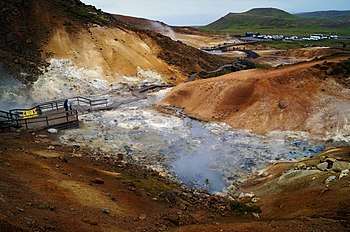

.jpg)
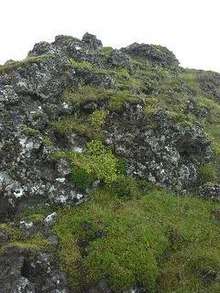
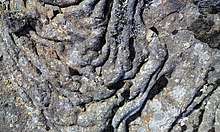
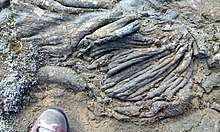
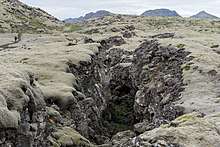
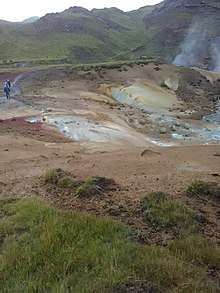
Situation within the volcano-tectonic environment on Reykjanes
It is one of 4 (or 5) volcanic systems situated within the Reykjanes Volcanic Belt.[1] The volcanic systems are arranged en echelon and in a certain angle (20 – 45°) to the rift zone of the divergent plate boundary traversing Reykjanes.
General characteristics
The volcanic system of Krýsuvík has no central volcano, but “a 50 km long, composite fissure swarm”,[2] i.e. a mixture of volcanic and tectonic fissures and faults, of which 30 km are volcanic fissures.[2] There are up to 2020 no submarine fissures known of the system which reaches from the south coast in direction SW to NE over the Reykjanes Peninsula. The northermost fissures are thought to reach Rauðavatn lake in the outskirts of Reykjavík.
The Krýsuvík volcanic system has a tendency to effusive basaltic fissure eruptions and the last eruption took place in the 14th century.[3]
There are no ice-covered volcanoes connected to the Krýsuvík system, but lake Kleifarvatn lies within the system and geothermal activity is to be found at the lake bottom.[2]
The eruption products of the Krýsúvik system consist exclusively of basalt.[2]
Eruptions
The volcanic system is centered on the divergent plate boundary on Reykjanes peninsula. For magma, because of the multitude of tectonic and volcanic faults and fissures in such regions, it is easier there to reach the surface.[2]
In the whole, there are at least 10 volcanic episodes known within the volcanic system in the last 8000 years. These episodes comprised each many single eruptions and were most probably connected to rifting.[2]
Some Holocene eruptions have been dated specifically, esp. the eruption that produced Búrfellshraun (ca. 5290 BP).[3]
Since the time of settlement in Iceland, which is thought to have been in the 9th century, some more eruptions have taken place within the system, all of them in the Middle Ages.[3]
The activity of Pleistocene shield volcanoes such as Þráinskjöldur and Hrútagjá as well as of tuyas like Fagradalsfjall within the volcanic system is seen as “separate from the fissure system”,[2] though the bigger volcanoes control parts of the topography.[2]
The Krýsuvík system has a tendency to phreatic explosions, often within rifting episodes and/or eruption series. The reason being that the underground of Reykjanes peninsula is soaked with water (high groundwater level as well as saline sea water in underground cave systems ).[1] There is especially the prehistoric maar complex around Grænavatn at Krýsuvík which has its origin in such explosions connected to a period of effusive eruptions.[1] There was also the explosion of an old borehole in 1999 at Seltún.[4][5]
Current situation
Some active geothermal high temperature areas are to be found in the system, especially at Seltún.
In the last years, repeated uplift episodes and earthquake series could be seen, probably connected to igneous intrusions. This took place esp. in Fagradalsfjall, which “is sometimes considered a separate volcanic system”.[2] This means it is attributed its own magma chamber by some scientists.
Craters, volcanic mountains and other volcanic landforms
Seltún
This area is situated next to Krýsuvík in direction of lake Kleifarvatn (Route 42).
It is a geothermal high temperature area,[4] hydrothermal alteration has led to a multicolored environment. Here solfataras, fumaroles, mud pots and hot springs are formed, the soil is coloured bright yellow, red, and green caused by iron oxidation, sulfur and calcite precipitation.
The sulfur deposits were mined in 1722–1728 and in the 19th century. German scientist Robert Bunsen visited the site in 1845 and, based on research there, proposed a hypothesis on formation of sulphuric acid in nature.[6]
The area can be visited on footpaths. A small hut provides services to the traveler.
Other volcanic landforms within the Krýsuvík volcanic system
Within the area of the Krýsuvík volcanic system are to be found e.g. the pyroclastic cone Búrfell (Hafnarfjörður) with its famous lava channel Búrfellsgjá, the Ögmundarhraun lava field from the 12th century as well as some Pleistocene subglacial mounds and formations like Helgafell (Hafnarfjörður), Sveifluháls and Trölladyngja (Reykjanes).
| Wikimedia Commons has media related to Krýsuvík (volcanic system). |
See also
- Brennisteinsfjöll volcanic system
- Reykjanes peninsula (Reykjanesskagi)
External links
General information
- http://icelandicvolcanos.is/?volcano=KRI Krýsuvík. Catalogue of Icelandic Volcanoes.
- https://volcano.si.edu/volcano.cfm?vn=371030 Krýsuvík. Global Volcanism Program. Smithsonian Institution.
Volcano monitoring
- https://en.vedur.is/earthquakes-and-volcanism/earthquakes/reykjanespeninsula/ Icelandic Met Office (IMO). Earthquake Monitoring. Reykjanes Peninsula
- https://en.vedur.is/earthquakes-and-volcanism/volcanic-eruptions/ IMO. Aviation Color Code
References
- Thorvaldur Thordarson and Ármann Höskuldsson: Postglacial volcanism in Iceland, Jökull no. 58, 2008. Retrieved 2 August 2020. (System no. 2 on the maps and tables)
- Krýsuvík. Catalogue of Icelandic Volcanoes. Retrieved 2 August 2020.
- https://volcano.si.edu/volcano.cfm?vn=371030 Krýsuvík. Global Volcanism Program. Smithsonian Institution. Retrieved 2 August 2020.
- https://en.isor.is/17-seltun-high-temperature-area-solfataras Seltún - High temperature area with solfataras. ÍSOR. Retrieved 2.August 2020.
- https://www.mbl.is/greinasafn/grein/1355609/ Morgunbaðið, 8. Nóvember 2010. Retrieved 2 August 2020
- "Krýsuvík – Seltún geothermal area". Wondermondo.
